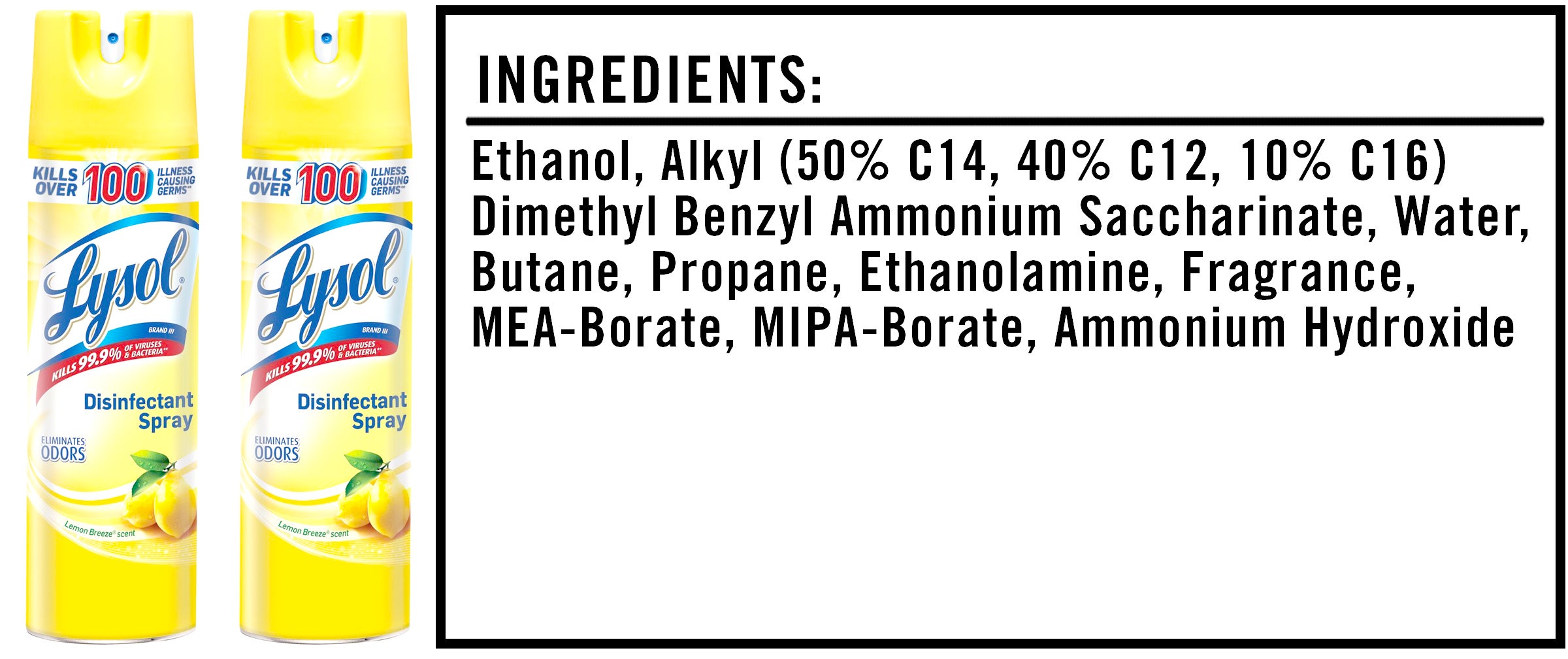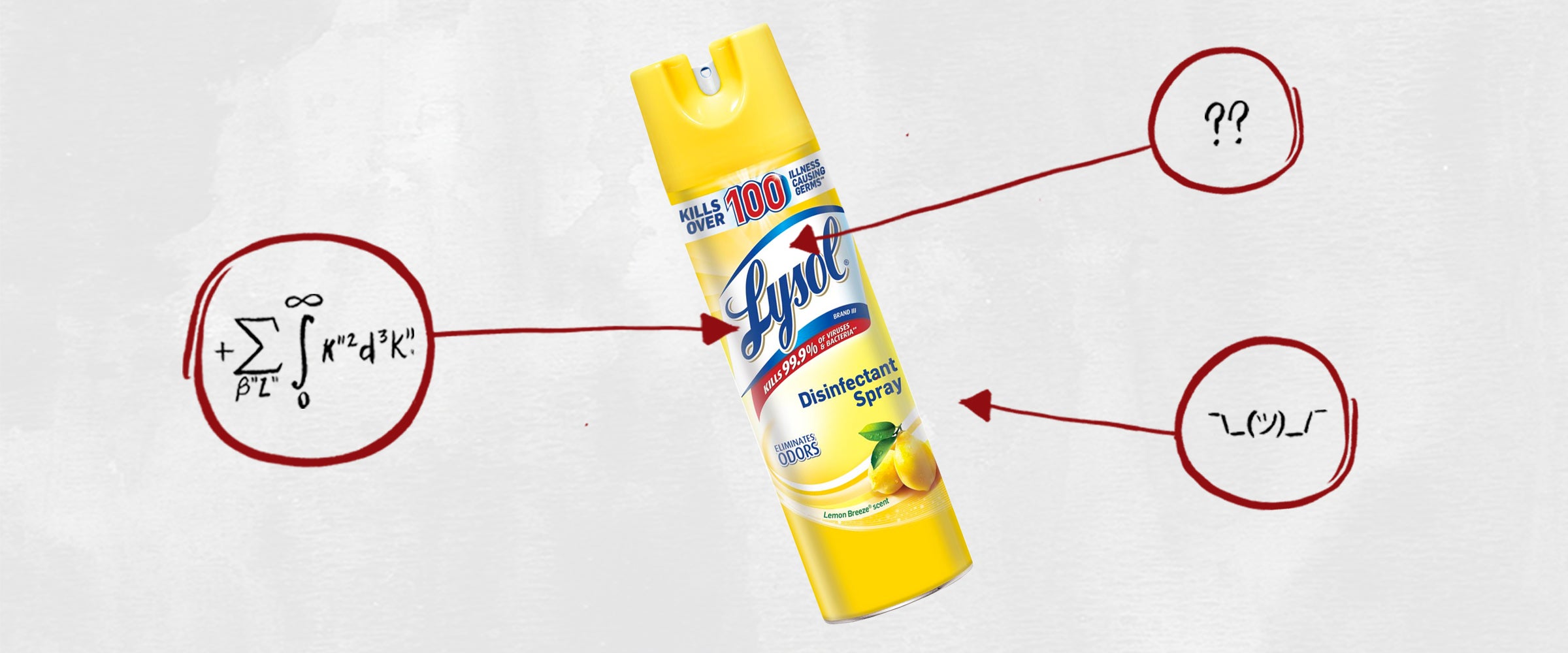We’re often told that you should never eat anything (or put anything on your body) if you don’t recognize everything on the ingredients list. But since most of us have no idea what xanthan gum or potassium benzoate are — or more importantly, what they’re doing to our bodies — we’re decoding the ingredients in the many things Americans put in (and on, or near) themselves.
This edition: Lysol Disinfectant Spray, which is made from 10 (well, kinda) separate ingredients that we’ve broken down in the exact order they appear on a product transparency website created by the global consumer products company RB, since the full list of ingredients is nowhere to be found on the Lysol website.

The Ingredients
1) Ethanol: One of the active ingredients in Lysol, ethanol is responsible for killing bacteria and viruses — and yes, Lysol can be effectively used against SARS-CoV-2, the cause of the coronavirus. Ethanol also happens to be the intoxicating ingredient in most forms of booze, but disinfectants like this one contain extremely strong concentrations of ethanol, along with numerous other toxic ingredients, so ingesting it could easily lead to alcohol poisoning and even death. So, you know, never ever consume Lysol, ever.
2) Alkyl (50% C14, 40% C12, 10% C16) Dimethyl Benzyl Ammonium Saccharinate: This is a conglomeration of ammonium-based compounds, also known as quaternary ammonium compounds, with antimicrobial properties that help destroy bacteria and viruses, including the coronavirus. They work by targeting the proteins in bacterial cells, essentially causing the cells to implode.
While extremely effective against germs, quaternary ammonium compounds are one of the big, bad ingredients in disinfectants that ravage our lungs, degrade the environment and can contribute to the evolution of superbugs when overused. Now, we should absolutely focus on being extra clean right now, but we also need to be careful not to overclean with potent disinfectants like Lysol, which could do more harm than good.
3) Water: This simply acts as a base for the other ingredients in Lysol.
4) Butane: In aerosols like Lysol, butane acts as a propellant, helping the disinfectant shoot out of the canister. Butane also happens to be highly flammable, and inhaling too much of it can mangle your central nervous system and result in some seriously nasty cardiac effects, so again, do your best to avoid consuming Lysol, even accidentally.
5) Propane: Another propellant, propane is also highly flammable and can damage your lungs and brain if inhaled in large quantities.
6) Ethanolamine: Ethanolamine functions primarily as a pH adjuster, keeping Lysol stable and maximizing its performance. While generally believed to be safe when used appropriately, yet again, ethanolamine can aggravate your skin and lungs, and in large doses, can damage your liver, kidneys and nervous system.
7) Fragrance: Unlike many products, where the fragrance ingredients are a complete mystery, RB actually lists several of the ones in Lemon Breeze Lysol. Most notably, it contains d-limonene, a terpene (odorous compound) obtained from the rinds of citrus fruits that smells like, well, citrus, and can help dissolve oils and stains. D-limonene has, however, been identified as a possible allergen, so watch out for that, especially if you have sensitive skin. The Lemon Breeze scent can also be attributed to some orange oils, which are relatively harmless odorous compounds.
8) MEA-Borate: MEA-borate is known as a corrosion inhibitor, helping maintain the freshness of this product. Compared to some other ingredients in Lysol, MEA-borate is relatively harmless.
9) MIPA-Borate: Another corrosion inhibitor, MIPA-borate has much more evidence of reproductive and developmental toxicity than MEA-borate, so once more, breathing in a bunch of Lysol is never great.
10) Ammonium Hydroxide: This is more commonly known as ammonia, which can be found in all sorts of cleaning products as a powerful degreaser. Of course, ammonia can be extremely toxic in large amounts when breathed in, so repeat after me: “I will not spray Lysol in my face.”
The Takeaway
To some degree, rabidly cleaning your home with products like Lysol, which contain robust, ammonium-based cleaning compounds, could be described as overkill, and some science suggests that green cleaners do just as good a job. In fact, even plain old soap and water can kill the coronavirus, if you scrub hard enough. Furthermore, experts seem to agree that the coronavirus in particular is spread primarily through person-to-person contact, rather than germs lingering on your doorknob or whatever, so focusing on hand washing is the move right now.
That said, the Centers for Disease Control and Prevention still recommend cleaning and disinfecting frequently touched surfaces in your home if someone in the household exhibits signs and symptoms of the coronavirus, and if dousing your apartment with Lysol makes you feel better right now, by all means, go ham. Just make sure to open a window.
Stuff You Should Know About the Coronavirus
- Here’s how to clean your food while you’re protecting yourself from COVID-19.
- Here’s why your Wi-Fi might feel slower in quarantine.
- Dry hands? Here’s a remedy. Make sure you’re moisturizing!
- HIV-positive people who lived through the AIDS crisis are experiencing a surreal and traumatic kind of déjà vu.
- At-home COVID-19 tests are, so far, total crap.
- Delivery drivers say they’re struggling to find places to pee and wash their hands.
- Coronavirus memes reveal how shameful the American health-care system really is.
- Many young people who tested positive didn’t realize they were carriers of COVID-19 — and they’re terrified they may have passed it to more vulnerable loved ones.
- Try to de-stress. Your immune system will thank you.
- You might want to take your clothes off as soon as you step inside your house.
- Restaurants are getting creative about selling bulk booze orders.
- It’s time to sit back and listen to some Steely Dan — the perfect music for the moment.

